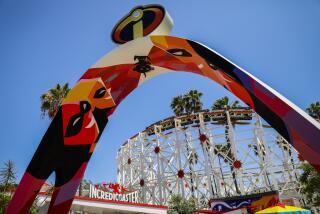Study Discounts Claims That Roller Coasters Can Cause Brain Damage
- Share via
Despite some claims that roller coasters can cause brain damage, a new study by University of Pennsylvania researchers is telling people to relax and enjoy the ride.
The study, published in the latest issue of the Journal of Neurotrauma, discounts allegations that the high-speed twists and turns associated with today’s most thrilling coaster rides can be hazardous to one’s health.
Using a mathematical model, neurosurgery professor Douglas H. Smith and bioengineering professor David F. Meaney analyzed how a rider’s head might react to the gravitational forces experienced on a roller coaster.
They concluded that even the most rough-and-tumble rides would not produce the levels of head acceleration needed to cause brain bleeds or other serious trauma to a normal, healthy person.
“We want to bring a little bit of balance to several shrill claims that roller coasters cause brain injury,” said Smith, who is working on a follow-up study using humans. The controversy over thrill rides and G-forces, he added, has been “blown out of proportion ... on a scattered series of case reports that are anecdotal at best.”
The study, which was funded by the National Institutes of Health, is adding more fuel to the debate over coaster safety during a time of increasing governmental efforts to regulate amusement parks, as well as litigation by people claiming to have been injured on a ride.
There have been several cases of brain injury allegedly associated with roller coasters in Southern California.
In June 2001, Pearl Santos, 28, suffered a ruptured aneurysm on the Goliath roller coaster at Six Flags Magic Mountain in Valencia. The stress and strain of the ride may have contributed to her death, a coroner’s report stated.
Santos’ parents have sued the park’s corporate owners, accusing them of knowingly operating a dangerous ride and inadequately warning patrons about its potential lethal hazards. The case is still pending.
Also last year, the Walt Disney Co. agreed to pay an undisclosed sum to settle a lawsuit with Deborah Bynum, 46, who said she suffered a brain hemorrhage while riding Disneyland’s Indiana Jones ride.
At the center of concerns of some doctors and government regulators are the effects of G-forces on riders, how long the forces last, how quickly and radically they change and whether a ride jolts back and forth abruptly.
Last month, New Jersey became the first state to regulate the level of G-forces in roller coasters. Next year, Rep. Edward J. Markey (D-Mass.) plans to reintroduce the Roller Coaster Safety Act, which would allow the federal government to investigate serious accidents at theme parks.
Markey’s office has compiled a list of at least 58 documented brain injury cases associated with roller coaster rides, ranging from preexisting aneurysms and brain hemorrhages to lesser incidents that resulted in headaches, nausea and vision problems. Eight cases were fatal.
The congressman also has asked the Brain Injury Assn. of America to convene a panel of experts, including Meaney, to review existing scientific literature and other documented medical cases.
The group is expected to present its findings next year. In the meantime, the University of Pennsylvania research is being lauded by roller coaster enthusiasts and the amusement park industry.
“Science bears out the impeccable safety of our parks and our rides,” said Bill Powers, spokesman for the International Assn. of Amusement Parks and Attractions. But others say the study falls short.
“It doesn’t explain why we’re seeing a rise in the injuries,” said Robert Braksiek, an emergency room physician in Cedar Rapids, Iowa. Braksiek wrote an earlier study, published in the Annals of Emergency Medicine, that found roller coaster riders face a small but real risk of brain injury caused by sudden stops and starts and directional changes.
Barry Novack, a Beverly Hills attorney who has filed six brain injury lawsuits against amusement parks, said the mathematical model using G-force data fails to simulate what real riders go through as they are tossed about like a “shaken baby” during a coaster ride.
“It’s not the acceleration, but the rapid change in acceleration that causes vessels to tear,” Novack said.
Smith countered that his study is all about changes in acceleration, and takes into account directional changes of a roller coaster that can cause a rider’s head to whip around.
A recent review conducted by a separate panel of medical and scientific experts for Six Flags Inc., which operates 39 amusement parks worldwide, has concluded that there is no evidence of any causal relationship between roller coasters’ G-forces and brain injuries.
“It’s more likely that these things happen by chance and that the roller coaster isn’t causing the problem,” said Robert Harbaugh, professor of neurosurgery at Dartmouth Medical School and director of Neuro-Knowledge, a collaboration between the American Assn. of Neurological Surgeons and the for-profit group Outcome Sciences, which conducted the study for Six Flags.
The company has not yet publicly released its study. Coaster enthusiasts say the most recent research merely corroborates what they knew all along, and that they would continue enjoying the rush of scream machines no matter what various studies say.
“My gut feeling is that they’ve got to be safe,” said Lisa Scheinin of Redondo Beach, who has ridden nearly 800 roller coasters around the world. “Look at how many millions of people go to amusement parks every year. How many of them have a problem?”
More to Read
Sign up for Essential California
The most important California stories and recommendations in your inbox every morning.
You may occasionally receive promotional content from the Los Angeles Times.














